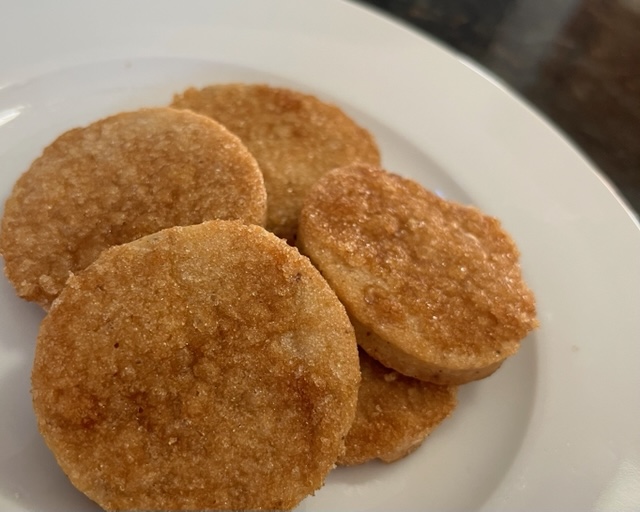Yield = 12-20 cookies, depending on size
Having a classic shortbread recipe in one's repertoire makes life so much easier, and more delicious.
This recipe, streamlined by the use of a food processor, is easy, versatile, and can even be made ahead of time. Perfect on it's own, decorated intricately, flavored inventively, or as a component in another dessert, you'll love the foolproof texture and taste of this classic.
350F, or 325F convection, middle rack.
Line 1 large rimmed baking sheet with parchment paper or grease the tray.
In a 4-8 quart food processor, mix in this order.
-flour, powdered sugar, salt, pulse for 15 seconds until combined. This might seem superfluous, but this process helps to properly suspend ingredients of different densities.
-cold butter, pulse for 30 seconds until mixture resembles damp sand. The mix should stick together slightly when pressed between your fingers, with very small pieces of butter evenly mixed throughout.
-with the processor running, add 1 teaspoon of cold water at a time until the dough just comes together in one mass. You might not need all the water initially measured.
As best as you can, shape your dough mass roughly with your hands into a rectangle shape. This shaping will help once you begin rolling.
Between two sheets of parchment paper or two silicone baking mats, place your mass evenly in the center. Begin rolling the dough mass in between the two sheets of parchment until the dough is 1/4 inch to 1/2 inch thick, depending on the desired thickness. Rolling the dough between the parchment sheets keeps your counters clean and enables you to handle the dough more easily.
At this point, you can lightly wrap your dough in plastic wrap, keeping the parchment paper intact, and freeze for up to one month. Otherwise, continue on to the resting step.
Chill dough, rolled and in between the parchment, in refrigerator for at least 15 minutes, or up to 24 hours.
Chilling shortbread dough helps improve the texture, taking it from cakey to chewy and more cookie-like by enabling the gluten to relax. It also gives the moisture more time to hydrate the dry ingredients. Don't skip this step.
After chilling, peel off the layers of parchment paper and begin cutting your dough into rectangles or punch out shapes with cutters or round drinking glasses. Keep in mind that intricate cutters may result in overbaked edges or lost definition in the shape.
If desired, you can dip the top portion of your shaped shortbread dough into white or brown granulated sugar before baking for added texture and flavor.
Bake in the oven until edges are set and just beginning to brown, 10-14 minutes, depending on the thickness and size of shortbreads, rotating the trays both vertically and horizontally after 6 minutes. This is a big range for baking, so just watch them closely toward the end to ensure they're the perfect bake for you. Golden edges are a great visual for ensuring they are done.
After baking is when you can further manipulate the texture of your cookies.
If you like them more crisp on the bottom, let cool completely on tray.
If you like them softer, or you fear you’ve overbaked them, remove from hot tray as soon as they’ll hold their shape; 1-2 minutes after they’re out of the oven.
A good in between is to let them cool 5-10 minutes, then move cookies to wire rack or cool plate.
Once cool, store in an airtight container for up to 5 days.
Different decoration elements can add a lot of flavor and texture to your shortbreads! They can be decorated with royal icing, simply glazed, drizzled with melted chocolate, or dusted with powdered sugar. The shortbreads make great jam filled sandwich cookies, and sugar can be baked into the top as instructed in the shaping directions.
As far as flavoring the dough, one can add dried herbs such as rosemary, thyme, or lavender to the dough. Simply pulse your herbs in with your dry ingredients while mixing. One could also use some liquor, juice, zest, or extract in place of part of the water measurement, just ensure your substitute is chilled.
Need inspiration? These are a great place to start!
Brown Sugar & Thyme
Add 3 teaspoons of fresh thyme leaves into your dry ingredients. Before baking, dip the top of your shortbread cookies into a thick layer of brown sugar.
Lime & White Chocolate & Coconut
Add 3 teaspoons of lime zest into your dry ingredients. Add 1 tablespoon of lime juice into your ice water measurement. Once baked, drizzle cookies with melted white chocolate and while drying, sprinkle flaked coconut onto the chocolate drizzles.
Jam Windows
Roll your shortbreads thin, no more than 1/4 inch. Cut your shortbreads with top cookies that have small windows in them (think like a doughnut, with the center hole missing), and leave some as whole large circles. When assembling, spread a thin layer of jam on the bottom shortbreads. Dust the top shortbreads with powdered sugar, and sandwich them together.
Ingredients
Directions
350F, or 325F convection, middle rack.
Line 1 large rimmed baking sheet with parchment paper or grease the tray.
In a 4-8 quart food processor, mix in this order.
-flour, powdered sugar, salt, pulse for 15 seconds until combined. This might seem superfluous, but this process helps to properly suspend ingredients of different densities.
-cold butter, pulse for 30 seconds until mixture resembles damp sand. The mix should stick together slightly when pressed between your fingers, with very small pieces of butter evenly mixed throughout.
-with the processor running, add 1 teaspoon of cold water at a time until the dough just comes together in one mass. You might not need all the water initially measured.
As best as you can, shape your dough mass roughly with your hands into a rectangle shape. This shaping will help once you begin rolling.
Between two sheets of parchment paper or two silicone baking mats, place your mass evenly in the center. Begin rolling the dough mass in between the two sheets of parchment until the dough is 1/4 inch to 1/2 inch thick, depending on the desired thickness. Rolling the dough between the parchment sheets keeps your counters clean and enables you to handle the dough more easily.
At this point, you can lightly wrap your dough in plastic wrap, keeping the parchment paper intact, and freeze for up to one month. Otherwise, continue on to the resting step.
Chill dough, rolled and in between the parchment, in refrigerator for at least 15 minutes, or up to 24 hours.
Chilling shortbread dough helps improve the texture, taking it from cakey to chewy and more cookie-like by enabling the gluten to relax. It also gives the moisture more time to hydrate the dry ingredients. Don't skip this step.
After chilling, peel off the layers of parchment paper and begin cutting your dough into rectangles or punch out shapes with cutters or round drinking glasses. Keep in mind that intricate cutters may result in overbaked edges or lost definition in the shape.
If desired, you can dip the top portion of your shaped shortbread dough into white or brown granulated sugar before baking for added texture and flavor.
Bake in the oven until edges are set and just beginning to brown, 10-14 minutes, depending on the thickness and size of shortbreads, rotating the trays both vertically and horizontally after 6 minutes. This is a big range for baking, so just watch them closely toward the end to ensure they're the perfect bake for you. Golden edges are a great visual for ensuring they are done.
After baking is when you can further manipulate the texture of your cookies.
If you like them more crisp on the bottom, let cool completely on tray.
If you like them softer, or you fear you’ve overbaked them, remove from hot tray as soon as they’ll hold their shape; 1-2 minutes after they’re out of the oven.
A good in between is to let them cool 5-10 minutes, then move cookies to wire rack or cool plate.
Once cool, store in an airtight container for up to 5 days.
Different decoration elements can add a lot of flavor and texture to your shortbreads! They can be decorated with royal icing, simply glazed, drizzled with melted chocolate, or dusted with powdered sugar. The shortbreads make great jam filled sandwich cookies, and sugar can be baked into the top as instructed in the shaping directions.
As far as flavoring the dough, one can add dried herbs such as rosemary, thyme, or lavender to the dough. Simply pulse your herbs in with your dry ingredients while mixing. One could also use some liquor, juice, zest, or extract in place of part of the water measurement, just ensure your substitute is chilled.
Need inspiration? These are a great place to start!
Brown Sugar & Thyme
Add 3 teaspoons of fresh thyme leaves into your dry ingredients. Before baking, dip the top of your shortbread cookies into a thick layer of brown sugar.
Lime & White Chocolate & Coconut
Add 3 teaspoons of lime zest into your dry ingredients. Add 1 tablespoon of lime juice into your ice water measurement. Once baked, drizzle cookies with melted white chocolate and while drying, sprinkle flaked coconut onto the chocolate drizzles.
Jam Windows
Roll your shortbreads thin, no more than 1/4 inch. Cut your shortbreads with top cookies that have small windows in them (think like a doughnut, with the center hole missing), and leave some as whole large circles. When assembling, spread a thin layer of jam on the bottom shortbreads. Dust the top shortbreads with powdered sugar, and sandwich them together.

